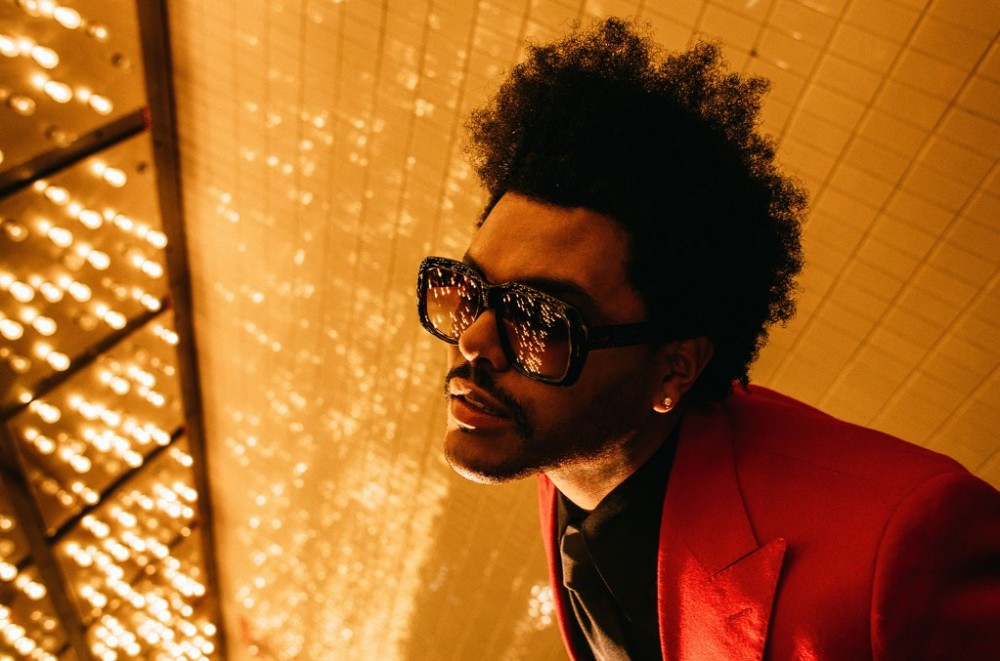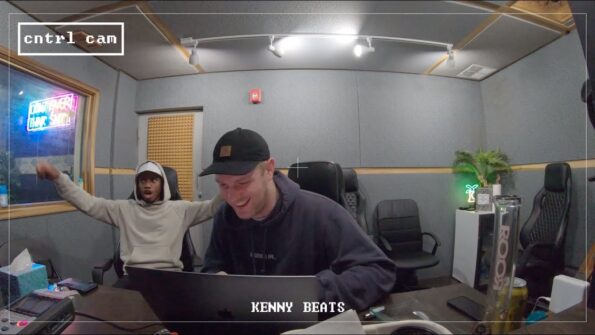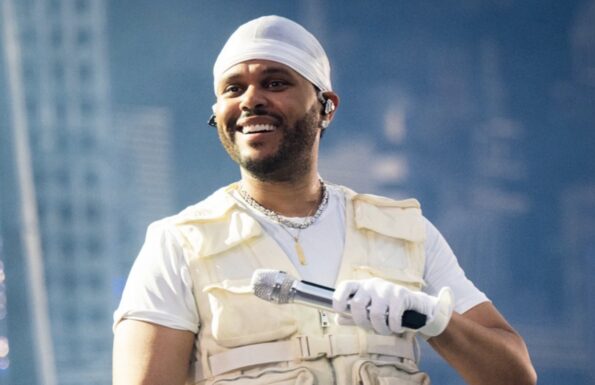The Internet had a good laugh last September when Abel Tesfaye, better known as The Weeknd, resurfaced on the red carpet of the Toronto Film Festival with a thin mustache and poofy, ‘fro-like hairdo, suddenly looking a whole lot like Bruno Mars.
Even Mars himself couldn’t help but chuckle about the comparison, making an Instagram meme of the occasion, poking fun at his new quasi-doppelgänger. But if the yuks bothered Tesfaye, he didn’t show it — instead leaning into the comparison by wearing big sunglasses and a red blazer against a Vegas backdrop in his new promotional materials, a seeming composite of Mars circa Unorthodox Jukebox and Mars circa 24K Magic. The visual comp underlined a truth that probably should have been more obvious to begin with: Bruno Mars and The Weeknd aren’t all that different as artists these days, either.
Such a statement would’ve been close to unimaginable in the early 2010s. Bruno Mars crashed onto top 40 in 2010 with familiar and accessible hits and the confidence of a man who’d always been there, while The Weeknd emerged a year later still shrouded in shadows, with inscrutable and extremely R-rated jams that were unplayable on radio. But fast forward to 2020, with Tesfaye’s fourth album After Hours due this Friday (Mar. 20), and the role they play in popular music is quite similar: Two retro-leaning, triple-threat singer-songwriters and hook men — with dynamite pop singles that don’t necessarily make you want to learn more about them as people — and two of the mainstream’s most consistently bankable stars and hitmakers.
While The Weeknd ending up a Mars-ian FM staple would’ve seemed unlikely at best in 2011, it was clear from before we ever even saw his face that he was a star of some kind. Debut mixtape House of Balloons arrived that year like a transmission from R&B’s future, a set of explicit, ghostly and gorgeously malevolent mini-epics, with explicit lyrics about drug, sex and hellish existential anguish, and musical influences from hip-hop, indie and even shoegaze. It combined for a sound that felt entirely new and instantly singular, and the allure of the project was only helped by the mystery of its unseen creator, as if it had materialized organically from Toronto’s late-night underbelly. Like Frank Ocean, R&B’s other most notable breakout enigma that year, you didn’t know what he was going to end up being, but you knew it was going to be important.
For two years afterwards, though, The Weeknd’s buzz receded. Two subsequent mixtapes followed in short succession, ultimately collected on the Trilogy compilation: Thursday had highs nearly to match Balloons‘ peaks, but without the emotional urgency or shock of the new that made his debut gripping from start to finish, while Echoes of Silence also had its dizzying moments but felt downright flat in stretches. All three mixtapes were strong listens and received positive reviews, but the overall excitement just couldn’t hold — particularly after Tesfaye made his public debut at Coachella in April 2012, revealing himself to be a somewhat uncomfortable live performer with little physical grace.
Still, even on these projects, certain songs pointed the way towards The Weeknd’s eventual pop metamorphosis. Thursday featured “The Zone,” his chilled-out first collaboration with TO countryman Drake — who would later give Tesfaye a big co-sign with two features in 2011 on his blockbuster sophomore LP, Take Care — as well as the acoustic “Rolling Stone,” in which the singer teased fans to get in on his seller’s market: “Love me, before they all love me.” Echoes also featured two big clues for Weeknd 2.0: “D.D.,” a grimy cover of Michael Jackson’s “Dirty Diana” that foreshadowed Abel’s eventual mid-career King of Pop infatuation, and Trilogy-only bonus track “Till Dawn (Here Comes the Sun),” whose stuttering synth hook carries the strong suggestion of dance-pop — though he wasn’t ready to fully explode with it yet.
He’d get much closer on “Wanderlust,” the climax of Kiss Land, his official-official 2013 debut album. Maybe the first Weeknd song that could accurate be described as upbeat, the song matched disco energy with Miami Vice atmospherics, though it still lacked the big hook to cross over in any meaningful way. It was also long: just over five minutes, which still made it one of the shorter songs on the largely overwrought Kiss Land. The set was just as musically wrenching as The Weeknd’s mixtapes, but also carried a harsher, grinding production edge — typified by centerpiece “Belong to the World” and its sample of the mercilessly hissing and spitting rhythm track to Portishead’s “Machine Gun.” It was a rewarding but exhausting listen, and with Tesfaye’s trademark sound by then inspiring myriad contemporary copycats to bleat in falsetto over darkly cinematic sonics, the thrill was gone. Kiss Land drew middling reviews and failed to produce a hit single, as Monday finally seemed to be approaching for The Weeknd.
While 2014 featured no full-length projects from the wayward singer-songwriter, it did allow him the opportunity for something of a soft reset. He surprised some fans by showing up as Ariana Grande’s co-star in her dance-pop romance “Love Me Harder,” his piercing wail an unexpectedly coherent match for Grande’s breathy tremble. The single was his biggest pop look to date, and his first real pop hit, hitting No. 7 on the Billboard Hot 100. Later in the year, The Weeknd also found his way to “Earned It,” the lead single from the much-anticipated film adaptation of E.L. James’ blockbuster erotic novel Fifty Shades of Grey. The waltzing ballad was hardly an entirely new métier for Tesfaye, whose slow jams were always highly theatrical — but it was an entirely new platform, and a true test of his capabilities as a pop leading man. He passed, as the song reached No. 3 on the Hot 100.
Still, nothing really could’ve prepared audiences for the pivot that would follow the next year. Reports of The Weeknd working with Swedish top 40 mastermind Max Martin on an MJ-like pop transformation felt almost comical for a guy who’d always seemed more in his sonic element with the Cocteau Twins and Beach House; the Fifty Shades theme was one thing, but surely this time he’d gone too far. But the results were no laughing matter: “Can’t Feel My Face” leaked in May 2015, with a shockingly convincing strobe-funk groove that felt both glossy and raw, a chorus that you know pretty instantly you’d be shouting with your friends and family at weddings for the rest of your life, and just enough nocturnal edge that no one could confuse Abel for Adam Levine. It was indeed as close as anyone had gotten to Michael and Quincy that decade, and quickly became his first No. 1 hit.
Beauty Behind the Madness arrived shortly afterwards, making it clear that The Weeknd was ably prepped for his turn in the spotlight. The songs were shorter, more digestible, the hooks were spaced out but massive, there was even a track with friggin’ Ed Sheeran on it. Tesfaye narrated his own star transformation on the soul-sampling “Tell Your Friends”: “Last year I did all the politicking/ This year, Imma focus on the vision.” That including fitting the image more, now, too: slimmer and sleeker-dressed in than his awkward 2012 debut, The Weeknd now looked (and moved) like a pop star in his music videos and live performances. Which isn’t to say that Tesfaye had sold out altogether: In fact, the biggest hit off Madness ended up not being “Face” or any of the set’s other dead-center ’80s pop tributes, but the blood-curdling seduction slasher “The Hills,” which made much of House of Balloons sound like Jason Derulo by comparison. The Weeknd’s name might’ve been above the top 40 poster now, but he was happier starring as the Joker than as Batman.
Still, The Weeknd was clearly at home in the mainstream now, and he seized on his forward momentum late the following year with third official LP Starboy. If Tesfaye was still being the slightest bit coy about his pop instincts and commercial aspirations on Madness, by Starboy they had become totally transparent: He even brags about winning a Teen Choice Award on “Reminder.” Only five of the set’s 18 tracks break the four-minute mark, and outside of the howling post-punk frenzy of “False Alarm,” none of them really risk the abrasive. But the set was a success, thanks in large part to its bookending singles, both collaborations with legendary French electrobots Daft Punk: the gleaming title track, a forever-ticking time bomb of tension and near-release (and his third No. 1 hit), and “I Feel It Coming,” a soaring slow-disco singalong every bit as Thriller-worthy as “Can’t Feel My Face.”
By the end of 2016, The Weeknd was one part of a hitmaking Canadian troika that, along with Drake and Justin Bieber, arguably represented the three biggest male pop stars in North America. But while those other two marquee names forged connections to their fans through their music that often seemed uncomfortably close, Tesfaye still felt at a distance in his songs. Unlike Drake, there was no Paris Morton or Courtney From Hooters on Peachtree in The Weeknd’s music, and unlike Justin Bieber, knowing the famous exes who might’ve inspired certain songs didn’t really make his songs richer — even despite the fact that they ultimately ended up sharing the same most-famous ex.
Actually, the closest thing to a vivid, meaningful personal relationship in The Weeknd’s songs is with frequent collaborator and fellow iconoclastic pop star Lana Del Rey, who shows up on Starboy as his “Stargirl,” and who he’s gone on record calling “the girl in my music — and I am the guy in her music.” It makes sense: artists stars rely so much on classic world-building and dramatic tropes in their pop music that they become indistinguishable as people from the quasi-characters they perform on record. When they play off each other, even on cartoonish album interludes, it feels like we get rare glimpses into the true nature of both.
The most Tesfaye has tried in recent years to reach “confessional” was with 2018 EP My Dear Melancholy, following his breakup with Selena Gomez — but the set mostly ended up just feeling like a stopgap, promotional material for his imminent return to Coachella, this time as a headliner. If that EP and the three singles dropped in advance of Friday’s After Hours show anything, it’s that our enjoyment of The Weeknd’s music no longer really requires him to develop as a person or a character. “Heartless,” the lukewarmly reviewed first release from the upcoming set, feels like its sentiment (“All this money and this fame got me heartless”) could have been photocopied from just about any point in Tesfaye’s career — the most revealing line in it comes when he lists off the magazine covers he’s been on recently. It still rocketed to the top of the Hot 100, his fourth career leader on the chart.
Even when The Weeknd’s music is short on revelations, it’s rarely light on hooks and grooves. “Blinding Lights,” released days after “Heartless” and now just three spots away from matching its chart peak, is the long-overdue culmination of Tesfaye’s long-simmering new wave fascination, a pulse-racing synth-pop killer — just in time to take advantage of pop radio finally cranking the BPMs back up — that sounds like Michael Sembello from the Maniac’s perspective. The set’s title track is nearly as good, a return to The Weeknd’s days of extended mutli-part odysseys, with a hypnotic beat that’s worth waiting the first 90 seconds for, and rocking with for the four-and-a-half minutes that follow.
The Weeknd’s decade-long career hasn’t followed the path anyone could have expected from his debut. And while he may never do anything as mind-warping or throat-stomping as that first trip to the House of Balloons again, it’s unquestionably a good thing that Tesfaye’s position in the mainstream is secure enough that he’s still able to take you places not a lot of hitmakers would feel comfortable going. Call it wasted potential that he’s no longer one of the country’s most exciting or acclaimed artists, but there are far worse fates in popular music than being Bruno Mars’ vampiric, Vegas-after-hours equivalent.



